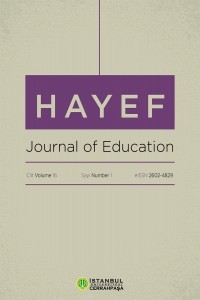DISCOVER TESTİNİN UZAMSAL-ANALİTİK BOYUTUNU N A-2 VE 3-5 FORMLARININ GEÇERLİK VE GÜVENİLİRLİK ÇALIŞMALARI
Bu araştırmanın temel amacı, DISCOVER Testi'nin, Uzamsal Analitik Zeka Ölçeği'nin (DISCOVER UAZÖ) A-2 ve 3-5 formlarının geçerlik ve güvenilirlik çalışmalarını yapmaktır. Araştırmanın örneklemini; geçerlik çalışması için, 51 üstün zekalı ve yetenekli ve 51 normal öğrenci; güvenilirlik çalışması içinse zeka tanılaması yapılmamış 49 öğrenci oluşturmaktadır. Araştırmada Raven'ın Standart Progresif Matrisler Testi, DISCOVER - UAZÖ'nin A-2 ve 3-5 formları ve araştırmacı tarafından geliştirilen Kişisel Bilgi Formu kullanılmıştır. Verilerin analizinde, DISCOVER UAZÖ'nin psikometrik özelliklerini belirlemek amacıyla, farklı ölçümler arasındaki ilişkilerin belirlenmesi için Pearson ve Diskriminant Fonksiyon analizleri kullanılmıştır. Araştırmada, DISCOVER-UAZÖ'nin 3-5 formunun sayfa sayısı ve üstünlük derecesi değişkenleri güvenilir çıkmışlardır. Yapılan Diskriminant Fonksiyon analizlerine göre de DISCOVER UAZÖ'nin bağımsız değişkenlerinin öğrencilerin üstün zekalı ya da normal olup olmadığını doğru kestirme olasılıklarının A-2 formu için % 61,9, 3-5 formu içinse % 65,5 olduğu tespit edilmiştir.
Anahtar Kelimeler:
Üstün Zekalı ve Yetenekli Çocuklar, Uzamsal Analitik Zeka, Mantıksal-Matematiksel Zeka, Problem Çözme Becerisi, DISCOVER - UAZ Ölçeği.
___
- Carroll, J.B. ve Maxwell, S.E. (1979). "Individual Differences in Cognitive Abilities", A n n u a l R e v i e w o f P s y c h o l o g y . 30, 603-640.
- Gardner, H. (1983). F r a m e s o f M i n d . New York: HarperCollins Publishers.
- Kyllonen, P.C., v e Glück, J. (2003). "Spatial ability: Introduction to the Spatial Isuue", I n t e r n a t i o n a l J o u r n a l o f T e s t i n g . 3/3, 215-217.
- Koshy, V. (2001). T e a c h i n g M a t h e m a t i c s t o A b l e C h i l d r e n . London: David Fulton Publishers.
- Linn, R.L. v e Gronlund, E. (2000). M e a s u r e m e n t a n d A s s e s s m e n t in T e a c h i n g (8. b a s k ı ) . New Jersey: Prentice-Hall, Inc.
- Maker, C.J., Nielson, A.B., v e Rogers, J. A. (1994). "Giftedness, Diversity, and Problem Solving", T e a c h i n g E x c e p t i o n a l C h i l d r e n . 2 7 / 1 , 4-19.
- Maker, C.J. (2001). " D I S C O V E R : Assessing and Developing Problem Solving", G i f t e d E d u c a t i o n I n t e r n a t i o n a l . 15, 2 3 2 - 2 5 1 .
- M u a m m a r , O.M., Maker, C.J. ve Kwang, C.C. (2004). Internal Structure of the DISCOVER Spatial Analytical Assessment, Unpublished manuscript, The University of Arizona.
- Raven, J. ve S u m m e r s , B. (1990). M a n u a l f o r R a v e n ' s P r o g r e s s i v e M a t r i c e s a n d V o c a b u l a r y S c a l e s : R e s e a r c h S u p p l e m e n t , No 3 (2. Ed). Oxford: Oxford Psychological Press.
- Sarouphim, K. (1999a). " D I S C O V E R : A Promising Alternative Assessment for the Identification of Gifted Minorities", G i f t e d C h i l d Q u a r t e r l y . 43/4, 244ı 2 5 1 .
- Sarouphim, K. (1999b). "Discovering Multiple Intelligences Through a Performance-Based Assessment: Consistency with Independent Ratings", E x c e p t i o n a l C h i l d r e n . 65, 151-161.
- Sarouphim, K. (2001). " D I S C O V E R : Concurrent Validity, Gender Differences, and Identification of Minority Students", G i f t e d C h i l d Q u a r t e r l y . 45, 130ı 138.
- Sternberg, R.J. (1999). "A Triarchic Approach to the Understanding and A s s e s s m e n t of Intelligence in Multicultural Populations", J o u r n a l o f S c h o o l P s y c h o l o g y . 37, 145-159.S
- Sternberg, R.J. ve Grigorenko, E.L. (2002). "The Theory of Successful Intelligence as a Basis for Gifted Education", G i f t e d C h i l d Q u a r t e r l y . 46/4, 265-277.
- Yavuzer, H. (2005). Ç o c u ğ u T a n ı m a k ve A n l a m a k (5. baskı). İstanbul: Remzi Kitabevi.
- Başlangıç: 2004
- Yayıncı: İstanbul Üniversitesi-Cerrahpaşa
Sayıdaki Diğer Makaleler
ÖĞRETMEN ADAYLARININ TARİHİ MEKANLARA VE ESERLERE İLİŞKİN GÖRÜŞLERİNİN İNCELENMESİ
Derya ÇIĞIR DİKYOL, Elif İNCE, Seda USTA
ÜSTÜN ZEKALI VE YETENEKLİLERİN ALAN EĞİTİMİNDE HIZLANDIRMA
Zehra ÖZSOY-GÜNEŞ, Yasemin DERELİOĞLU, F. KIRBAŞLAR
USTUN ZEKALI VE YETENEKLİLERDE CİNSİYET FARKLILIĞI
Çare SERTELİN MERCAN, S. YILDIZ
